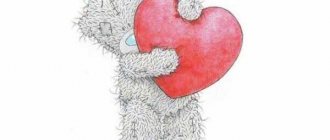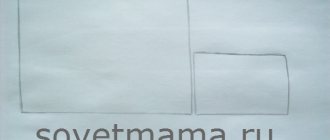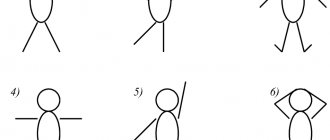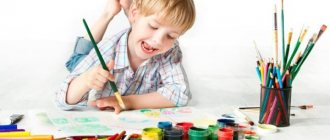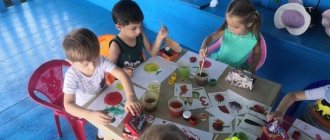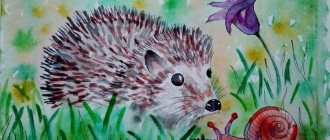Preview:
Summary of GCD drawing in the middle group
“According to plan” Teacher of the Saransk preschool educational institution “Kindergarten No. 43 of a combined type” Vlasova Alina Evgenievna
Develop creativity and imagination.
Handouts: Colored pencils, album sheet for each child.
Didactic material: Drawings as an example, Masha doll.
Contents of educational activities
1) Educator: Hello Guys, look who came to us today?
-That's right, Masha doll. Let's say hello to her! (Say hello)
-Look how sad the doll Masha is. She told me that she doesn't know how to draw. Guys, can you draw? (Yes)
2) -Let's draw a picture for the doll so that she won't be sad. (Yes)
-What would you like to draw for Masha? (Flower, toy, car)
-What interesting ideas you have, I also drew for the doll: an apple, a tree and a ball. (Hangs out drawings as examples)
-What will we draw today? (Pencils)
-What color are they? (Children begin to list colors)
-But before we draw, let's first stretch our fingers.
Finger gymnastics “Winter fun”
One, two, three, four, five, (bend the fingers on both hands)
It's snowing, let's go for a walk. (wavy movements of hands from top to bottom)
Don’t look for us, mom, (alternately touching identical fingers, starting with the thumbs)
We will build the hill. (connect the ends of your fingers at right angles)
It’s not a simple slide, (put your palms together)
Ice slide (join fingers at an angle)
We will try very hard, (clench your fingers into fists, raise your thumbs up)
So that you can ride it later. (use your right hand to stroke the back of your left hand)
Educator: Before drawing, straighten the backs and legs together. Let's remember how to hold a pencil correctly. (Show)
-The drawing must be drawn on the entire sheet (Follow the instructions)
-We paint completely (The teacher observes while working, helps if necessary)
3) Educator: What did we do today? (Drew drawings for Masha)
-What did you draw with? (Pencils)
(The teacher calls several children in turn to describe their work)
-Well done guys, Masha is glad that you drew so many drawings for her. Let's hang them on a board to admire. Masha will pick them up a little later.
-And now let's say goodbye to the doll Masha (Goodbye Masha!)
Source
Goal: to develop the ability to create plot compositions, consolidate ideas about the seasons, and continue to observe changes in nature in the fall.
Educational: develop an understanding of flowers, leaves and trees in autumn.
Developmental: develop observation, thinking, cognitive interest, attention, emotional responsiveness, the ability to create a plot composition.
Educators: to instill in children a caring attitude towards nature, interest and curiosity.
Lesson 22. Drawing according to plan
Program content.
Teach children to independently choose the theme of their drawing, bring their plans to completion, hold a pencil correctly, and paint over small parts of the drawing. Develop creativity and imagination.
Methodology of conducting the lesson.
Invite the children to think about what each would like to draw. Say that you can draw trees, bushes, benches and ladders in the kindergarten area; toys that children play with.
During the lesson, encourage an interesting idea, stimulate the addition of drawings with images that are suitable in meaning. Ask questions that encourage you to expand your idea.
When viewing the drawings, invite the children to choose the most interesting ones, and ask those who drew them to tell about them. Praise the guys who conceived and implemented the most interesting images.
Materials.
White paper 1/2 landscape sheet size, colored pencils (for each child).
Connections with other activities and activities.
Observations at the kindergarten site. Games in the play corner, reading books, looking at illustrations. Conversations about what interesting things the children saw that can be conveyed in a drawing.
Lesson 23. Application “Big House”
Program content.
Strengthen the ability to cut a strip of paper in a straight line, cut off corners, and compose an image from parts. Learn how to create an applique image of a large house. Develop a sense of proportions and rhythm. Reinforce techniques for careful gluing. Teach children to see an image when looking at work.
Methodology of conducting the lesson.
Invite the children to cut out and paste a large house (2-3 floors). Clarify the appearance of the house, its parts: roof, windows, doors, their location. Offer to think about how to cut windows, doors, and roofs from strips, and explain if necessary.
At the end of the work, put the images on the board, admire how many houses there are - several streets, a whole city.
Materials.
Paper 1/2 the size of a landscape sheet, rectangles of colored paper in light colors (different for all tables) and strips of colored paper for windows, doors, roofs; scissors, glue, glue brush, napkin, oilcloth (for each child).
Connections with other activities and activities.
Observations during walks, excursions around the village (city, town) during the construction of houses. Looking at illustrations.
Lesson 24. Modeling “Plums and Lemons”
Program content.
Continue to enrich children's understanding of oval-shaped objects and their depiction in modeling. Reinforce techniques for sculpting oval-shaped objects of different sizes and colors. Develop aesthetic perception.
Methodology of conducting the lesson.
Examine plums and lemons with the children and give them the opportunity to trace them. Invite the children to name their shape and show how they will sculpt plums and lemons. During the lesson, pay attention to each child, offer to achieve a better transfer of form.
In conclusion, review the finished work with the children and praise them for their efforts.
Materials.
Illustrations depicting plums and lemons (or dummies). Clay (plasticine), modeling board (for each child).
Connections with other activities and activities.
Conversations about fruits, looking at illustrations, educational games.
Lesson 25. Decorative drawing “Decorating a Sweater”
Program content.
Strengthen children's ability to decorate a piece of clothing using lines, strokes, dots, circles and other familiar elements; decorate clothes cut out of paper with decorated stripes. Learn to select colors according to the color of the sweater. Develop aesthetic perception, independence, initiative.
Methodology of conducting the lesson.
Show the children sweaters cut out of paper and offer to decorate them. Ask what can be done to make them beautiful. Invite the children to remember and show decoration techniques at the board. Ask where decorations can be placed. To say that every child decorates as he wants, beautifully choosing paint colors and arranging patterns. Provide assistance in color selection.
At the end of the lesson, lay out all the products on the table and examine them. Emphasize a beautiful combination of colors and pattern elements.
Materials.
Sweaters cut out of thick paper in different colors; strips of paper to fit the size of the cuffs, neckline, elastic band of the sweater; gouache paints, brushes, a jar of water, a napkin (for each child).
Connections with other activities and activities.
Examination of clothes decorated with decorative patterns; painting of Dymkovo and Filimonov toys.
Option. Drawing “Decorate the skirt of the Dymkovo young lady”
Program content.
Continue to introduce children to folk decorative art (Dymkovo painting). To cultivate respect for talented folk craftsmen who create bright folk toys. Practice painting techniques: vertical and horizontal stripes, checkered patterns, rings, dots, spots (dipping), etc. Strengthen the ability to paint with gouache paints and work with a brush. Develop a sense of color, a sense of rhythm.
Methodology of conducting the lesson.
Consider Dymkovo toys with children: young lady, water-carrier, nanny, lady; their elegant clothes, beautiful skirts. Invite children to highlight the elements of the pattern and color. Say that they can, using different decorations, paint the skirt of a Dymkovo young lady.
On the children’s tables there are silhouettes of Dymkovo young ladies cut out of paper (the blouse on them is painted over in light shades of different colors (each young lady has her own color)). Invite the children to think about how they want to paint the skirts and start drawing. While working, approach each child and ask how he will decorate his skirt. Remind the rules of drawing with a brush and paints. Lay out all the finished works on the table, look at them with the children, and admire their bright beauty. Note the variety of colors and techniques used.
Materials.
Silhouettes of Dymkovo young ladies (height up to 20 cm), cut out of paper by the teacher; gouache paints, brushes, a jar of water, a napkin (for each child).
Connections with other activities and activities.
Getting acquainted with Dymkovo toys, examining the painting of toys (drawing children's attention to colors, repetition of decoration elements; inviting them to show with hand movements the shape of pattern elements, their repetition and alternation).
Lesson 26. Application “Basket of Mushrooms” (Collective composition)
Program content.
Teach children to cut the corners of a square, rounding them. Strengthen the ability to hold scissors correctly, cut with them, and carefully glue parts of the image into the applique. Lead to a figurative solution, a figurative vision of the results of work, to their evaluation.
Methodology of conducting the lesson.
Start the lesson by reading a nursery rhyme about mushrooms, which the children were introduced to in lesson 13 “Mushrooms”. Invite the children to cut out and stick several mushrooms onto the “grass”. Show the technique of cutting corners, rounding them so that they fall off, you get a mushroom cap. Then show how to cut out the stem of the mushroom. While working, ensure proper use of scissors and cutting techniques.
Place the finished mushrooms in the basket with the children. At the end of the lesson, examine all the mushrooms in the basket and note the more expressive ones.
Materials.
A basket for mushrooms, drawn by the teacher and pasted onto a square sheet of paper so that there is space left for sticking mushrooms; colored paper rectangles for mushroom caps; white and light gray rectangles for mushroom stems, glue, glue brush, napkin, oilcloth (for each child).
Connections with other activities and activities.
Talk about summer. Looking at illustrations. Modeling mushrooms in class. Didactic games.
Lesson 27. Modeling “Different fish”
Program content.
Learn to convey the distinctive features of different fish that have the same shape, but slightly different from each other in proportions. Reinforce previously learned modeling techniques.
Methodology of conducting the lesson.
Consider two different fish with your children. Ask how they will sculpt the fish so that one is almost round and the other is long. Offer to show the corresponding movements in the air with your hands.
Analyzing the finished work, suggest finding long fish and placing them next to a fish of the same shape, and then finding rounder fish.
Materials.
Toy fish. Clay or plasticine, modeling board, stack (for each child).
Connections with other activities and activities.
Observing and caring for fish in the aquarium; looking at toys, illustrations, reading fairy tales.
Lesson 28. Drawing “Little Dwarf”
Program content.
Teach children to convey in a drawing the image of a little man - a forest gnome, making up an image from simple parts: a round head, a cone-shaped shirt, a triangular cap, straight arms, while observing the ratio in size in a simplified form. Strengthen the ability to draw with paints and a brush. Provide a figurative assessment of finished work.
Note.
During the lesson, you can draw any other little fairy-tale man in a long fur coat, from under which your legs are not visible.
Methodology of conducting the lesson.
Tell children about fabulous forest people - gnomes. Show a toy made of paper, examine it, trace the outline of the figure with your hand. Call one child to the board for a show and draw a gnome together: the head is drawn by the child, and the cone-shaped coat (shirt) and cap are drawn by the teacher and the child. Then all the children draw gnomes on their pieces of paper.
At the end of the work, look at all the drawings, invite the children to choose the most beautiful, elegant gnomes or the funniest, cheerful, sad (grumpy, silent, etc.). Hang the works in a group so that children can look at them and enjoy their drawings.
Materials.
Gnome (volume), made of paper. Paper 1/2 the size of a landscape sheet, gouache paints, brushes, a jar of water, a napkin (for each child).
Connections with other activities and activities.
Telling and reading fairy tales, looking at illustrations and toys.
Lesson 29. Modeling “Duck” (Based on a Dymkovo toy)
Program content.
Introduce children to Dymkovo toys (ducks, birds, goats, etc.), pay attention to the beauty of the continuous streamlined shape, specific coloring, painting. Develop aesthetic feelings. Learn to convey the relative size of parts of a duck. Reinforce the techniques of smearing, smoothing, flattening (duck beak).
Methodology of conducting the lesson.
When exhibiting Dymkovo products in front of children, note their unusualness, the beauty of a white toy with a bright, elegant pattern. Ask what the pattern is made of. Invite the children to sculpt a duck. Examine the toy, ask what techniques they will use when doing the work.
Consider all the images sculpted by the children and choose the most expressive ones.
Materials.
Dymkovo toys. Clay, modeling board (for each child).
Lesson 30. Drawing “Fish swim in an aquarium”
Program content.
Teach children to depict fish swimming in different directions; correctly convey their shape, tail, fins. Strengthen the ability to draw with a brush and paints, using strokes of a different nature. Foster independence and creativity. Learn to mark expressive images.
Methodology of conducting the lesson.
Recall with your children how they watched fish swimming in an aquarium. Invite them to draw fish on the board in different positions: eating (opening their mouth and swallowing food), swimming, floating up or catching up with each other, resting in the seaweed. Show how you can paint a fish in different ways (with stripes, strokes, dots, etc.). During the drawing process, encourage the image of large and small fish and algae swimming in different directions.
First, children draw fish with colored wax crayons (thick pastels). When the fish are drawn, the teacher places jars of watercolor paints diluted to a light shade (blue, light green, etc.) on the tables for painting the water in the aquarium.
When looking at finished images, draw children's attention to the expressiveness of the drawings.
Materials.
Toy fish of different shapes and sizes. Landscape sheets or sheets of paper of round or oval shape (aquarium); watercolor paints diluted to a light shade (blue, light green, etc.); colored wax crayons, brushes, a jar of water, a napkin (for each child).
Connections with other activities and activities.
Watching fish in an aquarium with children (how they swim in different directions, wagging their tails and fins). Looking at algae. Modeling fish.
Lesson 31. Modeling according to the plan “Make whatever vegetables or fruits you want for the game of shop”
Program content.
Teach children to choose the content of their work from a range of certain subjects. Foster independence and activity. Strengthen the ability to convey the shape of vegetables and fruits using a variety of sculpting techniques. Develop imagination.
Methodology of conducting the lesson.
Find out what vegetables and fruits children know. Invite them to name their shape, and then sculpt what vegetables and fruits they want (each child must sculpt several objects).
Remind the children that they need to divide the column of clay (a stick of plasticine) into 2-3 lumps. Make sure that children do not sculpt very finely, to achieve a more accurate representation of the shape.
Consider all the sculpted vegetables and fruits, note their diversity, emphasize the independence of children in choosing objects for sculpting.
Materials.
Clay (plasticine, plastic mass), modeling board, stack (for each child).
Connections with other activities and activities.
Didactic or printed board games that use vegetables and fruits or their images.
Option. Modeling “Make what you want beautiful”
Program content.
Continue to develop and enrich children's ideas about beauty. To develop the ability to choose sculpting techniques to create a sculptural image. Cause a positive emotional reaction to the offer to create something beautiful.
Methodology of conducting the lesson.
Invite the children to think and say that they know beauty. To what the children named, add a number of simple (available to them for depiction in modeling) objects and objects.
Materials.
Clay (plasticine), modeling board, stack (for each child).
Connections with other activities and activities.
Reading books, learning poems. Didactic and theatrical games, games with toys, observations while walking. Conversations, conversations with children about beauty.
Preview:
Theme: “Golden Autumn”
Goal: to develop the ability to create plot compositions, consolidate ideas about the seasons, and continue to observe changes in nature in the fall.
Educational: develop an understanding of flowers, leaves and trees in autumn.
Developmental: develop observation, thinking, cognitive interest, attention, emotional responsiveness, the ability to create a plot composition.
Educators: to instill in children a caring attitude towards nature, interest and curiosity.
Demonstration material: Autumn flowers and leaves, painting by I. Levitan “Golden Autumn”.
Handouts: sheets of paper, paints, brushes, cups of water, cloth napkins, easel.
Methodological techniques: artistic expression, conversation, questions and answers, examination of a reproduction of a painting, physical education, productive activity of children, analysis of work, summing up.
On the topic: methodological developments, presentations and notes
Abstract of GCD in a preparatory group for school on artistic and aesthetic development, using non-traditional drawing techniques Topic: “Golden Autumn”.
Lesson summary for the senior group: non-traditional drawing theme “Golden Autumn” monotype technique Purpose: To introduce preschool children to non-traditional techniques.
Abstract of educational activities on non-traditional drawing “Golden Autumn” (middle group) Integration of educational areas: “artistic creativity (drawing)”, “mu.
Abstract of educational activities on non-traditional drawing “Golden Autumn” (middle group) Integration of educational areas: “artistic creativity (drawing)”, “mu.
The goals of the teacher’s activities: to introduce children to a new unconventional drawing technique - printing with leaves, to consolidate the children’s ability to carefully use paint when working, and to develop imagination.
Form of organization: workshop for the production of children's creativity products. Purpose: to draw an autumn tree.
Source
Drawing according to plan in the senior group of preschool educational institutions. Our smaller brothers
Educational field : artistic and aesthetic development Age group: senior preschool age (5-6 years) Topic : Drawing according to the plan Our smaller brothers Main objectives: 1) introduce the unconventional drawing technique “poking with a hard brush” 2) develop the ability to convey expressively in drawing images of domestic animals (body shape, location and shape of body parts, their size, proportions) based on diagram 3) form and develop artistic and creative abilities in children; 4) develop coherent speech, thinking, creative imagination; 5) cultivate accuracy in working with various visual materials; Didactic materials and equipment : an envelope with a letter, pictures of domestic animals, diagrams of the structure of animals, brushes, white sheets of paper, gouache paints, glasses of water, cotton swabs Progress of the educational situation:
1. Introduction to the game situation. Didactic objectives: to motivate children to engage in gaming activities. The teacher gathers the children around him.
- Guys, today I received a letter from our friend Buratino.
Let's read it. “My dear friends!
I really want to have a friend. c - our smaller brothers. And besides the dog, I don’t know any others. I hope you can help me find out about them. Your friend, Buratino” - Do you want to help Buratino?
-Can you do this? 2. Updating knowledge. Didactic objectives: 1) update children’s knowledge about domestic animals; 2) develop attention and speech - How can we help Pinocchio? (children’s answers) - Yes, guys, we can not only tell, but also draw. People call animals “our little brothers.” Why do you think the person called it that way? (because we must love and care for them, protect them if necessary, like real brothers). — Do you think it’s easy to have an animal friend? (not easy, animals need to be fed, played with, treated if sick). I know that some of you already have beloved pets, while others are just dreaming of one. Who, guys, really want to tell us about their friend. Think, remember his name, what he looks like. Tell us what he likes to do most. Now let's play! Finger gymnastics: Animals have 4 paws (raise and lower 4 fingers on their hands) Claws can scratch (we depict claws) It’s not their face, but their muzzle (join fingers into a ball, bring them closer to the face) Tail, mustache, and wet nose (“wave” ", show the mustache, trace the nose) And, of course, the ears! (three ears) Only on the top of the head (show with hands) - I really liked the stories about your pets. Let's draw a friend for our Pinocchio. First, let's remember what shape you can draw a torso? - What shape can a head be? Ears? Paws? What are our animals covered with? 3. Difficulty in the situation Didactic tasks: 1. Create a motivational situation for further analytical activity; 2. To form experience, under the guidance of a teacher, of recording the difficulty and understanding its cause. 3. Train mental operations: analysis, comparison, develop logical thinking, speech. - Who knows how to draw fur? — Today we will draw using the unconventional “poke” technique — Can you show and tell us how to do this? (Children offer various methods) - Was everyone able to understand how to draw fur using the non-traditional “poke” technique? - Why do you think you couldn’t understand? (Because we don't know how to do it). — What do you need to know now? (learn how to draw fur using the non-traditional “poke” technique) 4. Discovery of new knowledge Didactic tasks: 1. Guide children to find a solution to a problem situation; 2. To form the experience of independent discovery and experience of overcoming difficulties; 3. Fixation of a new method of action in speech; 4. Train mental operations: logical thinking, speech, imagination, creativity, fine motor skills, communication skills. - How can we find out? (Look in a textbook, ask someone who knows, or come up with it yourself). Children ask the teacher how to draw animals using the “poke” method. The teacher shows how to draw in this way: striking with a brush along the entire contour of the drawn animal, and then inside it. Please note that wool may have shades of a different color. Then, with a thin brush, he tints the eyes, nose, and ears. - Do you remember how to draw? We must try not to go beyond the contour line. - Try to make your pet beautiful and fluffy. Physical exercise : Hold the brush like this (hand on the elbow, hold the brush with three fingers above its metal part) Is this difficult? No, it’s nothing (moving the hand along the text) Right - left, up and down Our hand ran. And then, and then (the brush is held vertically) The brush runs around (they poke without paint on the sheet) It spins like a top. After a poke comes a poke! 5. Inclusion of new knowledge (method of action) into the child’s system of knowledge and skills. Didactic tasks: 1. To consolidate an unconventional way of drawing. 2. Train mental operations: logical thinking, speech, imagination, creativity, fine motor skills, communication skills. - Let each of you draw your favorite pets - friends who live in your home or maybe you just like some kind of animal. During the work, the teacher monitors how the children draw: reminds them not to put a lot of paint on the brush, but only lightly touch the surface of the paint so that the print has an air-colored surface; First complete one element to completion, only then proceed to the next. 6. Comprehension Didactic tasks:
- to form the experience of comprehending one’s own activities, recording the achievement of the planned result and the conditions that allowed it to be achieved.
The teacher gathers children around him.
- Guys, were we able to help Pinocchio? — How did you manage to draw such fluffy animals? What helped you? (we got acquainted with an unconventional drawing technique) - What is the name of this technique? (poke)
We recommend watching:
Summary of educational activities in the senior group “Northern Adventures” Summary of a conversation with children of senior preschool age Summary of educational activities in speech therapy for the senior group Methodological development of a summary of an excursion for children of senior preschool age
Similar articles:
Summary of a mathematics lesson in the senior group of kindergarten. Geometric figures
Preview:
Topic: Drawing by design in the middle group.
Goal: to create conditions for developing the ability to draw simple plots according to plan.
Objectives: Teach children to independently choose the theme of their drawing, bring their plans to the end, hold the brush correctly, and paint over small parts of the drawing. Develop creativity and imagination. To promote the ability to convey mood in a drawing. Develop fine motor skills of fingers, manual skill, creativity, imagination. To cultivate curiosity and interest in understanding the nature of the native land and its reflection in the drawing.
Integration of educational areas: Speech, cognitive, artistic and aesthetic development
Preliminary work: Conversation about paintings, nature, animals, artists, seasons.
1. Introduction to the game situation
Guys, take your seats in the auditorium, because today an interesting story will take place in the theater.
October
Lesson 12. Drawing “Golden Autumn”
Program content. Teach children to depict autumn. Practice drawing a tree, trunk, thin branches, autumn foliage. Strengthen technical skills in painting with paints (dip the brush with all its bristles into a jar of paint, remove an extra drop on the edge of the jar, rinse the brush well in water before adding another paint, blot it on a soft cloth or paper napkin, etc.). Lead children to figurative transmission of phenomena. Foster independence and creativity. Induce a feeling of joy from bright, beautiful drawings.
Lesson 13. Modeling “Mushrooms”
Program content. Strengthen children's ability to sculpt familiar objects, using previously learned sculpting techniques (rolling clay with straight and circular movements, flattening with palms, sculpting with fingers) to refine the shape. Lead to a figurative assessment of work.
Lesson 14. Drawing “Fairytale tree”
Program content. Teach children to create a fairy-tale image in a drawing. Practice the ability to convey the correct structure of a tree. Learn to paint. Develop imagination, creativity, speech.
Lesson 15. Application “Decoration of a handkerchief”
Program content. Teach children to identify the corners and sides of a square. Reinforce knowledge of round, square and triangular shapes. Practice choosing color combinations. Learn to transform shapes by cutting a square into triangles, a circle into semicircles. Develop compositional skills and color perception.
Lesson 16. Decorative drawing “Decorating an apron”
Program content. Teach children to make a simple pattern from elements of folk ornament on a strip of paper. Develop color perception, figurative ideas, creativity, imagination.
Lesson 17. Modeling “Treats for dolls”
Program content. To develop children's imaginative ideas and the ability to choose the content of an image. Learn to sculpt a selected object using previously learned techniques. Continue to develop the ability to work accurately. To cultivate the desire to do something for others, to develop the ability to combine the results of one’s activities with the work of peers.
Lesson 18. Application “Boats float on the river”
(“Fishing boats went to sea”, “Yachts on the lake”)
Program content. Teach children to create images of objects by cutting off the corners of rectangles. Strengthen the ability to create a beautiful composition and carefully paste images.
Lesson 19. Modeling “Fish”
Program content. To consolidate knowledge of techniques for making oval-shaped objects (rolling with straight movements of the palms, sculpting with fingers). Reinforce the techniques of pulling and flattening while conveying the characteristic features of the fish. Teach children to use a stack to represent the scales covering the body of a fish.
Lesson 20. Drawing with paints “Simple and golden eggs”
Program content. To consolidate knowledge of the oval shape, the concepts of “blunt” and “sharp”. Continue teaching the technique of drawing an oval shape. Train children in the ability to carefully paint over drawings. Lead to figurative expression of content. Develop imagination.
Lesson 21. Modeling “Make whatever toy you want as a gift to a friend (brother, sister)”
Program content. Continue to develop imagery, imagination and creativity. To consolidate the ability to use a variety of sculpting techniques learned earlier when creating an image. Cultivate attention to other children, a desire to take care of them.
On the topic: methodological developments, presentations and notes
Drawing with paints. (fingers).
Summary of an open lesson on drawing in a non-traditional way (poke drawing + emerging drawing) middle group “Animals of our zoo.” compiled by Kuznetsova Svetlana Vladimirovna Put.
The purpose of this lesson is to teach children to reflect the plot of an episode from a fairy tale, conveying its characteristic features: characters, their appearance, emotions, correspondence of the plot to the text of the fairy tale.
This material is aimed at developing fine motor skills of the fingers, creativity, and imagination.
Summary of GCD on modeling according to design in the middle group.
Goal: to study the appearance, character, behavior and habits of the fox. Objectives: to develop the ability to see and name parts of the animal’s body; introduce a new way of depicting the torso and head in f.
Notes for children with disabilities on hearing in the preparatory group.
Source
"Drawing by Design." Summary of GCD in the middle group
Svetlana Panchekhina
"Drawing by Design." Summary of GCD in the middle group
Topic: “By design ”
Program content: Teach children to independently choose the theme of their drawing, bring their plans to the end, hold a pencil correctly, and paint over small parts of the drawing. Develop creativity and imagination. Foster independence.
Materials: colored pencils, album sheets for each child.
Ioo: cognitive development; speech development.
1. Organizational moment. The teacher invites the children to remember what they drew before . (Children's answers.)
Then the teacher explains that today they will
each draw what they want, asking the children what they would like to draw .
2. Drawing technique . The teacher reminds you of the rules of drawing : the ability to hold a pencil correctly, draw large on the entire sheet , paint over the drawing with a pencil, drawing lines and strokes in one direction (from top to bottom or left to right, not to go beyond the contour.
3. Independent work of children, the teacher helps individually, if necessary. While drawing, the teacher encourages an interesting idea , stimulates the addition of drawings with images that have a similar meaning, and asks questions that encourage them to expand the idea . After finishing the work, the teacher invites the children to attach the finished drawings to the magnetic board, examine them, choose the most interesting ones, and ask those who drew them to tell about them. The teacher praises the children who conceived and implemented the most interesting images.
4. Finger gymnastics “Fingers went for a walk”
.
One two three four five,
The fingers went out for a walk (Children clench and unclench their fingers)
This finger found a mushroom,
(Children tap their thumb lightly)
5. Summary: What did you do today? What did you draw with ? What did you draw ?
Long-term planning for drawing (middle group) Topic: Large and small carrots. Goal: Learn to depict oval-shaped objects, placing them on the entire sheet and conveying the main color.
Summary of an integrated lesson in fine arts in the middle group on the topic: Autumn
Lesson summary for the middle group: Golden autumn has come to visit us
Summary of an integrated lesson on artistic creativity in the middle group “Golden autumn has come to visit us”
Author: Oksana Vladimirovna Kozlova, teacher of GBDOU No. 57, Kolpino St. Petersburg Description: the material is intended for middle age, it will be useful for teachers in joint activities with children . Goal: Development of creative imagination, to cultivate a love for nature, a desire to take care of it. To develop the ability to admire nature and the beauty of autumn. Improve skills and abilities to work in a team. Objectives: - To consolidate children’s knowledge about autumn, its signs, to be able to understand the signs of autumn. — To cultivate an aesthetic attitude towards nature through the depiction of flowers. — To develop the ability to arrange objects in space on a sheet of paper. — To improve children’s ability to convey in drawings the joyful mood associated with the arrival of autumn, the ability to be creative. Preliminary work: Walks, observing autumn changes, reading fiction, conversations, looking at illustrations of autumn landscapes.
Collecting autumn leaves and examining them Materials: Pictures about autumn, pictures depicting the seasons, whatman paper, album sheets, a simple pencil, gouache, PVA glue, napkins, brushes for gouache and glue. Progress of the lesson:
Educator: Approaches the children to the window and reads a poem by A. Fet The swallows disappeared And yesterday the dawn All the rooks were flying Yes, like a net, they flashed over that mountain Over there I haven’t been able to sleep since the evening It’s dark in the yard. The dry leaf falls, At night the wind gets angry, And knocks on the window. Conversation with children: - Guys, what did you feel when you listened to the poem? (sad, sorrowful, cold, etc.) - I felt sad too. Summer has passed, autumn has come. Let's go for a walk in the autumn forest. Lie down on the carpet, close your eyes and imagine that you are riding a bicycle for a walk in the forest. (Children lying on their backs with their eyes closed perform the “bicycle” exercise).
Educator: That's it guys, we've arrived in the forest, put your bikes down. And let's take a walk through the forest and admire the autumn forest. Look how beautiful the autumn forest is, what colorful trees, how many leaves lie under your feet. This is a real golden autumn. Let's collect them. Children collect leaves and spin with them to the music.
We've played, now let's relax. Game with a ball “Name the signs of autumn” To whom the ball is thrown, he names the signs of autumn (for example, it has become colder outside, it rains often, the leaves turn yellow and fall, etc.)
Now let's play with our fingers. Finger gymnastics “Mushrooms” is being carried out. One, two, three, four, five! “Fingers are walking on the table.” We are going to look for mushrooms. This finger went into the forest, they bent one finger at a time. This finger found a mushroom, starting with the little finger. This finger began to clean, This finger began to fry, This finger ate everything, That’s why it got fat. Now guys need to go home, lie down on the carpet, close your eyes and imagine that you are riding a bicycle. We are returning home. We've arrived. Educator: Did you guys like the walk in the forest? We all walked together and played together. Let's make an “autumn tree of friendship” together. Work with children was carried out in 2 stages. Stage 1: Children traced their palms with a simple pencil and painted over them with gouache.
Stage 2: The children glued the finished cut palms onto the tree. This is how beautiful the “Autumn Tree of Friendship” turned out.
We recommend watching:
Summary of GCD in the middle group “Mushroom Glade” Summary of GCD. My city Zheleznogorsk Summary of GCD in the middle group with elements of experimentation Integrated GCD for speech development and artistic creativity in the middle group
Similar articles:
Lesson summary for the middle group: Safety at home
Summary of a lesson in kindergarten “Receiving guests.” Middle group
Lesson summary for the middle group on the topic: Properties of glass
Lesson in the middle group of kindergarten. Village courtyard
Summary of a lesson on cognitive development in the senior group. Rules of conduct in the circus
Summary of the GCD lesson on drawing according to plan in the preparatory group “Golden Autumn”
Zavyalova Yulia
Summary of the GCD lesson on drawing according to plan in the preparatory group “Golden Autumn”
Type of activity : drawing according to plan .
Topic of the lesson : “ Golden Autumn ”.
Purpose of the lesson .
To cultivate love, interest in native nature, the ability to notice the beauty of golden autumn , its color and convey it in a drawing.
Strengthen the skills and ability to mix paints, gouache, to obtain new shades and use them in work.
Develop children's aesthetic perception and creativity.
Vocabulary work: activate children's vocabulary: rowan, maple, birch, sky, blossoms, bright red.
Materials: gouache (green, yellow, red)
, album sheets of paper.
